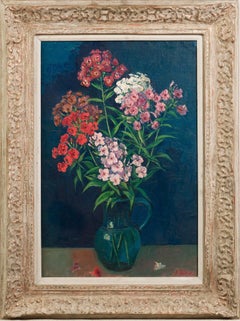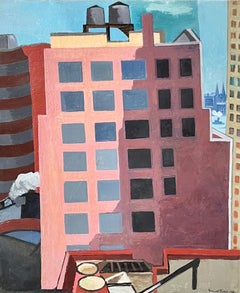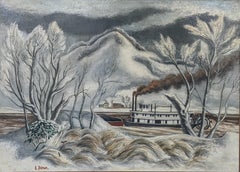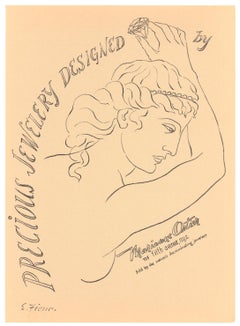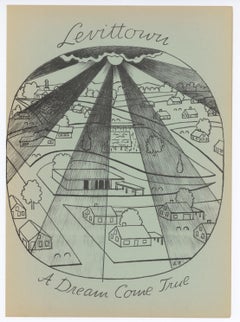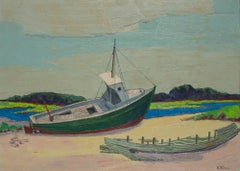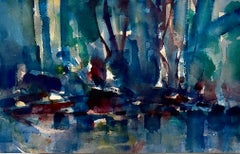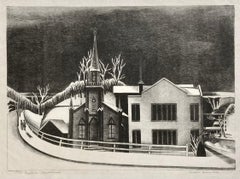Ernest Fiene Art
to
2
10
10
9
4
3
1
Phlox Flower Still Life Oil Painting Antique Exhibited Large Framed Oil Painting
By Ernest Fiene
Located in Buffalo, NY
Antique oil on canvas by Ernest Fiene (1894 - 1965) . This work was exhibited at Midtown Galleries. Housed in its original modernist frame as well. Perfect and ready to hang! Tit...
Category
1930s Modern Ernest Fiene Art
Materials
Canvas, Oil
NYC Cityscape American Scene WPA Modern Realism Mid 20th Century Architectural
By Ernest Fiene
Located in New York, NY
NYC Cityscape American Scene WPA Modern Realism Mid 20th Century Architectural
Ernest Fiene (1894-1965)
Cityscape
36 x 30 inches
Oil on canvas
Signed and dated 1930. lower right
Provenance
Estate of the artist.
ACA Galleries, New York
Exhibited
New York, Frank Rehn Gallery, Changing Old New York, 1931.
New York, ACA Galleries, Ernest Fiene: Art of the City, 1925-1955, May 2-23, 1981, n.p., no. 5.
BIO
Ernest Fiene was born in Elberfeld, Germany in 1894. As a teenager, Fiene immigrated to the United States in 1912. He studied art at the National Academy of Design in New York City from 1914 to 1918, taking day classes with Thomas Maynard and evening classes with Leon Kroll. Fiene continued his studies at the Beaux-Arts Institute of Design in New York from 1916 to 1918, adding classes in printmaking at the Art Students League in 1923.
Fiene began his career as an artist in 1919 with his first exhibition of watercolors at the MacDowell Club arranged by his mentor Robert Henri. In 1923 the Whitney Studio Club mounted a large exhibition of his works. The following year he had an exhibition at the New Gallery in New York, which completely sold out all fifty-two works, including paintings, watercolors, drawings, and etchings. With the proceeds of sales from the New Gallery exhibition, Ernest Fiene and his younger brother Paul, a sculptor, built studios in Woodstock, New York in 1925.
In the early Twenties Ernest Fiene painted mostly landscapes of Woodstock and both the Ramapo and Hudson River Valleys. The first monograph from the Younger Artists Series was published on Fiene in 1922. Published in Woodstock, the series went on to include Alexander Brook, Peggy Bacon, and Yasuo Kuniyoshi. The book reproduced 1 illustration in color and another 27 reproductions in black and white. Around 1925 Fiene became fascinated with the intensity, excitement, and opportunities for color harmonies New York City offered as a subject. His paintings shifted to urban and industrial themes with architecture, industry, and transportation becoming his subjects.
By 1926 Fiene had attracted the dealer Frank K.M. Rehn, who gave him a one-man exhibition that year, which travelled to the Boston Arts Club. C.W. Kraushaar Galleries gave Fiene a one-man exhibition of urban, landscape, portrait, and still life paintings in 1927. Julianna Force, the director of the Whitney Studio Club and first director of the Whitney Museum of American Art, included two of Fiene’s paintings in a fall exhibition in 1928. The Whitney Studio Club showed Fiene’s paintings in a two-man exhibition with Glenn O. Coleman that year and acquired three of Fiene’s paintings. Also in 1928 Fiene became affiliated with Edith Halpert’s Downtown Gallery where he had an exhibition of 20 lithographs in the spring. Fiene sold his house in Woodstock in 1928 to spend more of his time in New York City.
With so many successful exhibitions, Fiene returned to Paris in 1928-29 where he rented Jules Pascin's studio and studied at the Académie de la Grande Chaumière. In France, Fiene painted both landscape and urban subjects developed from ideas influenced by Cubist geometry and the use of flat areas of broad color. Upon returning to New York in 1930, Fiene used this new approach to continue to paint New York skyscraper and waterfront subjects, as well as to begin a series of paintings on changing old New York based on the excavations for Radio City Music Hall and the construction of the Empire State Building. Frank K.M. Rehn Galleries exhibited this series, titled “Changing Old New York,” in 1931. Fiene also has solo exhibitions at Rehn Galleries in 1930 and 1932. Fiene’s oil paintings are exhibited at the Chicago Arts Club in 1930 as well.
Fiene was included in the Museum of Modern Art’s exhibition Painting and Sculpture by Living Americans in December of 1931. Visiting New York, Henri Matisse saw the exhibition and called Fiene’s Razing Buildings, West 49th Street the finest painting he had seen in New York. Fiene had two mural studies from his Mechanical Progress series exhibited at the Museum of Modern Art’s exhibition Murals by American Painters and Photographers in 1932. Fiene sent View from my Window which depicts Fiene working on a lithograph stone while looking out his window to the newly completed Empire State Building to the Carnegie International in 1931. In 1932 Fiene participated in the first Biennial of American Painting at the Whitney Museum and his prints were included in exhibitions at the Downtown Gallery and the Wehye Gallery. In the same year, Fiene was awarded a Guggenheim fellowship to further study mural painting in Florence, Italy.
On his return from Italy in 1933 Fiene re-engaged himself in New York City life and won several public and private mural projects. Fiene resumed his active exhibition schedule, participating in two group exhibitions at the Whitney Museum and a one-man exhibition of recent paintings at the Downtown Gallery in January 1934. In 1933 he purchased a farm in Southbury, Connecticut, which added Connecticut scenes to his landscape subjects. This was also the year Fiene began to spend summers on Monhegan Island, Maine, where he painted seascapes, harbor scenes, and still lifes.
Fiene’s landscape paintings attracted numerous commissions as part of the American Scene movement. Through the fall and winter of 1935-36, Fiene took an extended sketching trip through the urban, industrial, and farming areas of Pennsylvania and West Virginia. Most of the twenty-four Pennsylvania urban and rural paintings...
Category
1930s American Modern Ernest Fiene Art
Materials
Canvas, Oil
"Along the Kanahawa River, West Virginia, " Ernest Fiene, WPA Coal Steamboat
By Ernest Fiene
Located in New York, NY
Ernest Fiene
Along the Kanahawa River, West Virginia, 1936
Signed lower right
Oil on canvas
26 x 36 inches
Fiene made a series of paintings, drawings and lithographs which are based on his travels through Pennsylvania and West Virginia during the winter of 1935-36. The industrial areas of Pennsylvania and West Virginia are represented in numerous oils, among which are some of his most well-known. Fiene wrote of the trip, "The increasing snow and atmospheric conditions [in the Kanawha River valley} enhanced this mountainous coal mining country with a majestic beauty."
Winter on the River is Fiene's only American Artists Group print and there were only two lithographs produced from the West Virginia trip. The American Artists Group (AAG), under the direction of Carl Zigrosser, who was then working at New York's famed Weyhe Gallery, published ninety-three prints by over fifty artists in 1936 and 1937. Zigrosser's goal was to popularize contemporary American art through original prints offered at the low price of $2.75. The project was also a means to provide income for impoverished artists during the Depression. The prints were featured in many of the leading print exhibitions and publications of the period. The lithograph produced from this image is now in the collection of the Amon Carter Museum, Baltimore Museum of Art, Cleveland Museum of Art, Philadelphia Museum of Art, Pensacola Museum of Art, San Francisco Fine Arts Museum, Syracuse Museum, Yale University Art Museum.
Ernest Fiene was born in Elberfeld, Germany in 1894. As a teenager, Fiene immigrated to the United States in 1912. He studied art at the National Academy of Design in New York City from 1914 to 1918, taking day classes with Thomas Maynard and evening classes with Leon Kroll. Fiene continued his studies at the Beaux-Arts Institute of Design in New York from 1916 to 1918, adding classes in printmaking at the Art Students League in 1923.
Fiene began his career as an artist in 1919 with his first exhibition of watercolors at the MacDowell Club arranged by his mentor Robert Henri. In 1923 the Whitney Studio Club mounted a large exhibition of his works. The following year he had an exhibition at the New Gallery in New York, which completely sold out all fifty-two works, including paintings, watercolors, drawings, and etchings. With the proceeds of sales from the New Gallery exhibition, Ernest Fiene and his younger brother Paul, a sculptor, built studios in Woodstock, New York in 1925.
In the early Twenties Ernest Fiene painted mostly landscapes of Woodstock and both the Ramapo and Hudson River Valleys. The first monograph from the Younger Artists Series was published on Fiene in 1922. Published in Woodstock, the series went on to include Alexander Brook, Peggy Bacon, and Yasuo Kuniyoshi. The book reproduced 1 illustration in color and another 27 reproductions in black and white. Around 1925 Fiene became fascinated with the intensity, excitement, and opportunities for color harmonies New York City offered as a subject. His paintings shifted to urban and industrial themes with architecture, industry, and transportation becoming his subjects.
By 1926 Fiene had attracted the dealer Frank K.M. Rehn, who gave him a one-man exhibition that year, which travelled to the Boston Arts Club. C.W. Kraushaar Galleries gave Fiene a one-man exhibition of urban, landscape, portrait, and still life paintings in 1927. Julianna Force, the director of the Whitney Studio Club and first director of the Whitney Museum of American Art, included two of Fiene’s paintings in a fall exhibition in 1928. The Whitney Studio Club showed Fiene’s paintings in a two-man exhibition with Glenn O. Coleman that year and acquired three of Fiene’s paintings. Also in 1928 Fiene became affiliated with Edith Halpert’s Downtown Gallery where he had an exhibition of 20 lithographs in the spring. Fiene sold his house in Woodstock in 1928 to spend more of his time in New York City.
With so many successful exhibitions, Fiene returned to Paris in 1928-29 where he rented Jules Pascin's studio and studied at the Académie de la Grande Chaumière. In France, Fiene painted both landscape and urban subjects developed from ideas influenced by Cubist geometry and the use of flat areas of broad color. Upon returning to New York in 1930, Fiene used this new approach to continue to paint New York skyscraper and waterfront subjects, as well as to begin a series of paintings on changing old New York based on the excavations for Radio City Music Hall and the construction of the Empire State Building. Frank K.M. Rehn Galleries exhibited this series, titled “Changing Old New York,” in 1931. Fiene also has solo exhibitions at Rehn Galleries in 1930 and 1932. Fiene’s oil paintings are exhibited at the Chicago Arts Club in 1930 as well.
Fiene was included in the Museum of Modern Art’s exhibition Painting and Sculpture by Living Americans in December of 1931. Visiting New York, Henri Matisse saw the exhibition and called Fiene’s Razing Buildings, West 49th Street the finest painting he had seen in New York. Fiene had two mural studies from his Mechanical Progress series exhibited at the Museum of Modern Art’s exhibition Murals by American Painters and Photographers in 1932. Fiene sent View from my Window which depicts Fiene working on a lithograph stone while looking out his window to the newly completed Empire State Building to the Carnegie International in 1931. In 1932 Fiene participated in the first Biennial of American Painting at the Whitney Museum and his prints were included in exhibitions at the Downtown Gallery and the Wehye Gallery. In the same year, Fiene was awarded a Guggenheim fellowship to further study mural painting in Florence, Italy.
On his return from Italy in 1933 Fiene re-engaged himself in New York City life and won several public and private mural projects. Fiene resumed his active exhibition schedule, participating in two group exhibitions at the Whitney Museum and a one-man exhibition of recent paintings at the Downtown Gallery in January 1934. In 1933 he purchased a farm in Southbury, Connecticut, which added Connecticut scenes to his landscape subjects. This was also the year Fiene began to spend summers on Monhegan Island, Maine, where he painted seascapes, harbor scenes, and still lifes.
Fiene’s landscape paintings attracted numerous commissions as part of the American Scene movement. Through the fall and winter of 1935-36, Fiene took an extended sketching trip through the urban, industrial, and farming areas of Pennsylvania and West Virginia. Most of the twenty-four Pennsylvania urban and rural paintings from this trip were featured in an exhibition held at the First National Bank in Pittsburgh in October of 1937 by the Pittsburgh Commission for Industrial Expansion. Fiene said of these works that he formed rhythm, opportunity for space and color, and integrity in the Pennsylvania mill and furnace paintings. Fiene received the silver medal for one of the Pittsburgh paintings...
Category
1930s American Realist Ernest Fiene Art
Materials
Canvas, Oil
original lithograph
By Ernest Fiene
Located in Henderson, NV
Medium: original lithograph. This lithograph is from the rare 1953 "Improvisations" portfolio, published by the Artists Equity Association of New York on the occasion of the 1953 Spr...
Category
1950s Ernest Fiene Art
Materials
Lithograph
original lithograph
By Ernest Fiene
Located in Henderson, NV
Medium: original lithograph. This lithograph is from the rare 1952 "Improvisations" portfolio, published by the Artists Equity Association of New York on the occasion of the 1952 Spr...
Category
1950s Ernest Fiene Art
Materials
Lithograph
"Low Tide at Noon, Wellfleet, Massachusetts, " Ernest Fiene, WPA, Boat on Beach
By Ernest Fiene
Located in New York, NY
Ernest Fiene (1894 - 1965)
Low Tide at Noon, Wellfleet, Massachusetts
Oil on canvas
26 x 36 inches
Signed lower right
Ernest Fiene was born in Elberfeld, Germany in 1894. As a teenager, Fiene immigrated to the United States in 1912. He studied art at the National Academy of Design in New York City from 1914 to 1918, taking day classes with Thomas Maynard and evening classes with Leon Kroll. Fiene continued his studies at the Beaux-Arts Institute of Design in Paris from 1916 to 1918, adding classes in printmaking at the Art Students League in 1923.
Fiene began his career as an artist in 1919 with his first exhibition of watercolors at the MacDowell Club arranged by his mentor Robert Henri. In 1923 the Whitney Studio Club mounted a large exhibition of his works. The following year he had an exhibition at the New Gallery in New York, which completely sold out all fifty-two works, including paintings, watercolors, drawings, and etchings. With the proceeds of sales from the New Gallery exhibition, Ernest Fiene and his younger brother Paul, a sculptor, built studios in Woodstock, New York in 1925.
In the early Twenties Ernest Fiene painted mostly landscapes of Woodstock and both the Ramapo and Hudson River Valleys. He was the subject of the first monograph for the Younger Artists Series in 1922. Published in Woodstock, the series went on to include Alexander Brook, Peggy Bacon, and Yasuo Kuniyoshi. The book reproduced 1 illustration in color and another 27 reproductions in black and white. Around 1925 Fiene became fascinated with the intensity, excitement, and opportunities for color harmonies New York City offered as a subject. His paintings shifted to urban and industrial themes with architecture, industry, and transportation becoming his subjects.
By 1926 Fiene had attracted the dealer Frank K.M. Rehn, who gave him a one-man exhibition that year, which travelled to the Boston Arts Club. C.W. Kraushaar Galleries gave Fiene a one-man exhibition of urban, landscape, portrait, and still life paintings in 1927. Julianna Force, the director of the Whitney Studio Club and first director of the Whitney Museum of American Art, included two of Fiene's paintings in a fall exhibition in 1928. The Whitney Studio Club showed Fiene's paintings in a two-man exhibition with Glenn O. Coleman that year and acquired three of Fiene's paintings. Also in 1928 Fiene became affiliated with Edith Halpert's Downtown Gallery where he had an exhibition of 20 lithographs in the spring. Fiene sold his house in Woodstock in 1928 to spend more of his time in New York City.
With so many successful exhibitions, Fiene returned to Paris in 1928-29 where he rented Jules Pascin's studio and studied at the Académie de la Grande Chaumière. In France, Fiene painted both landscape and urban subjects developed from ideas influenced by Cubist geometry and the use of flat areas of broad color. Upon returning to New York in 1930, Fiene used this new approach to continue to paint New York skyscraper and waterfront subjects, as well as to begin a series of paintings on changing old New York based on the excavations for Radio City Music Hall and the construction of the Empire State Building. Frank K.M. Rehn Galleries exhibited this series, titled "Changing Old New York," in 1931. Fiene also has solo exhibitions at Rehn Galleries in 1930 and 1932. Fiene's oil paintings are exhibited at the Chicago Arts Club in 1930 as well.
Fiene was included in the Museum of Modern Art's exhibition Painting and Sculpture by Living Americans in December of 1931. Visiting New York, Henri Matisse saw the exhibition and called Fiene's Razing Buildings, West 49th Street the finest painting he had seen in New York. Fiene had two mural studies from his Mechanical Progress series exhibited at the Museum of Modern Art's exhibition Murals by American Painters and Photographers in 1932. Fiene sent View from my Window which depicts Fiene working on a lithograph stone while looking out his window to the newly completed Empire State Building to the Carnegie International in 1931. In 1932 Fiene participated in the first Biennial of American Painting at the Whitney Museum and his prints were included in exhibitions at the Downtown Gallery and the Wehye Gallery. In the same year, Fiene was awarded a Guggenheim fellowship to further study mural painting in Florence, Italy.
On his return from Italy in 1933 Fiene re-engaged himself in New York City life and won several public and private mural projects. Fiene resumed his active exhibition schedule, participating in two group exhibitions at the Whitney Museum and a one-man exhibition of recent paintings at the Downtown Gallery in January 1934. In 1933 he purchased a farm in Southbury, Connecticut, which added Connecticut scenes to his landscape subjects. This was also the year Fiene began to spend summers on Monhegan Island, Maine, where he painted seascapes, harbor scenes, and still lifes.
Fiene's landscape paintings attracted numerous commissions as part of the American Scene movement. From 1935-36 Fiene took an extended sketching trip through the urban, industrial, and farming areas of Pennsylvania and West Virginia. Most of the twenty-four Pennsylvania urban and rural paintings from this trip were featured in an exhibition held at the First National Bank in Pittsburgh in October of 1937 by the Pittsburgh Commission for Industrial Expansion. Fiene said of these works that he formed rhythm, opportunity for space and color, and integrity in the Pennsylvania mill and furnace paintings. Fiene received the silver medal for one of the Pittsburgh paintings...
Category
Mid-20th Century American Realist Ernest Fiene Art
Materials
Canvas, Oil
Winter Evening Fifth Avenue - New York at Night - Mid-Century.
By Ernest Fiene
Located in Miami, FL
Mid-century New York City is represented as a moment in time. The artist populates his scene with isolated figures that are more shapes of people as opposed to specific individuals....
Category
1950s Post-Impressionist Ernest Fiene Art
Materials
Oil, Canvas
Winter Evening Fifth Avenue - New York at Night
By Ernest Fiene
Located in Miami, FL
Ernest Fiene depicts Fifth Avenue looking down from 57th Street with an unobstructed view of the Empire State Building. The absence of newer glass and steel architecture gives the painting the charm of old New York. The artist captures a dark, moody blue sky as light bounces back from the clouds. This contrasts with the somewhat haunting yellow glow given to pedestrians and street traffic. The people have somewhat of a zombie quality akin to George Tooker. Best viewed with a top and direct gallery light...
Category
1950s Post-Impressionist Ernest Fiene Art
Materials
Oil, Canvas
Ernest Fiene, Connecticut Village Landscape, Oil Painting, circa 1921
By Ernest Fiene
Located in New York, NY
Signed by the artist and dated 1921 in the front lower right corner, this oil on board painting, in all probability, depicts a small Connecticut village by a lake.
Ernest Fiene (18...
Category
20th Century American Other Ernest Fiene Art
Materials
Paint
Thistles with Greek Relief
By Ernest Fiene
Located in Boston, MA
Ernest Fiene, American (1894-1965), Thistles with Greek Relief, 1948
Signed lower right: "E. Fiene". Titled and signed on stretcher: "Thistles with Gree...
Category
1940s Realist Ernest Fiene Art
Materials
Oil
Related Items
Modernist Abstract Expressionist Watercolor Painting Bauhaus Weimar Pawel Kontny
By Pawel Kontny
Located in Surfside, FL
Abstract watercolor composition bearing the influence of the earlier color-block compositions of Paul Klee.
Pawel August Kontny, (Polish-German-American artist) He was born in Laurahuette, Poland, in 1923, the son of a wealthy pastry shop owner. In 1939 he began studying architecture in Breslau where he was introduced to the European masters and to the work of some of the German Expressionists, soon afterward banned as "degenerate artists" and removed from museums throughout Germany by the Nazi regime. His studies were interrupted by World War II. Drafted into the German army, traveling in many countries as a soldier, he sketched various landscapes but in 1945, he was captured and held as a prisoner of war in Italy. After the war, he studied at the Union of Nuremberg Architects to help design buildings to replace ones destroyed in the war. He recorded his impressions of the local population and the landscapes through his watercolors and drawings. Pawel Kontny thereafter moved to Nuremberg, Germany, becoming a member of the Union of Nuremberg Architects and helping to rebuild the city's historic center. He soon decided to concentrate on his professional art career. He married Irmgard Laurer, a dancer with the Nuremberg Opera. Pavel Kontny 's career as an artist was launched with his participation in an all German exhibition, held at the Dusseldorf Museum in 1952. He held one-man shows in Germany, Switzerland and the United States. During his trip to the United States in 1960, Kontny became instantly enamored with Colorado, and decided to relocate to Cherry Hills with his wife and two children. He quickly established himself in the local art community, being affiliated for a time with Denver Art Galleries and Saks Galleries. His subject matter became the Southwest. During this time he received the Prestigious Gold Medal of the Art Academy of Rome. His extensive travel provided material for the paintings he did using his hallmark marble dust technique. he also worked equally in pastel, watercolor, charcoal and pencil-and-ink. in a style which merged abstraction and realist styles, influenced by Abstract Expressionist painting and South Western American landscapes. In the early 1960s he was one of only a few European-born professional artists in the state, a select group that included Herbert Bayer (1900-1985), a member of the prewar Bauhaus in Weimar and Dessau, Germany, and Roland Detre (1903-2001), a Hungarian modernist painter. As a Denver, Colorado resident, Pavel Kontny exhibited at galleries and museums throughout the United States, Germany and Japan. There, he was inspired by frequent trips to Native American pueblos in the Southwest, as well as by the study of the Plains Indians of Montana and Wyoming. Over the years Kontny had a number of students and generously helped young artist by hosting exhibitions at his Cherry Hills home. For many years he generously donated his paintings to support charitable causes in Denver. Influences during his European years included German pastelist C.O. Muller, German Informel painter Karl Dahmen and Swiss artist, Hans Erni. In the early 1950s his painting style showed the influence of the Die Brücke (The Bridge), a group of German expressionist artists formed in Dresden in 1905 who had a major impact on the evolution of modern art in the twentieth century in Germany. By the middle of the decade his style incorporated more referential abstraction and total abstraction, resulting in part from his study of Hans Hartung, a German artist based in Paris who exhibited his gestural abstract work in Germany. The American moon landing in 1969 inspired Paul Kontny...
Category
20th Century American Modern Ernest Fiene Art
Materials
Canvas, Oil
20th Century German Modernist Oil Painting Colorful Still Life of Flowers
Located in Cirencester, Gloucestershire
Artist: Elisabeth Hahn (German 1924-2021)
Elisabeth Hahn was born in Dortmund, Germany, where she began her artistic studies. In 1953, she moved to Paris. She continued her studies ...
Category
20th Century Modern Ernest Fiene Art
Materials
Canvas, Oil
"Misty City", Oil Painting
By Christopher Clark 1
Located in Denver, CO
Christopher Clark's (US based) "Misty City" is an original, handmade oil painting that depicts orange and green hued clouds arching over a water and city lights
Bio/artist statement:
Christopher has been an artist since early childhood, when he would watch Bob Ross on PBS and mimic the famed oil painter’s art with crayons. He considers himself a self-educated artist, with his studies ranging from personal training with contemporary masters, to classical academic art technique, with much inspiration from 19th Century art and the Impressionist Movement. Christopher lived in Italy for a time, immersing himself in Italian culture and art, which continues to influence his painting. His fan base has grown considerably since his return to the US, gaining the attention of Lucasfilm and Marvel Fine Art, which both signed him as an officially licensed artist in 2016. Other clients include George Lucas, Major League Baseball, Louisville Slugger...
Category
2010s American Realist Ernest Fiene Art
Materials
Canvas, Oil, Panel
Large Trompe L'oeil Hyperrealism Painting Abstract Surrealist Photo Realist Art
Located in Surfside, FL
Large acrylic painting by Pat Rosenstein, American Woman Artist, graduate of Pratt Institute whose work has been exhibited extensively. Rosenstein, who...
Category
1990s American Modern Ernest Fiene Art
Materials
Canvas, Acrylic
Fauvist Still Life with Fruit Basket and Books
By Anthony Rappa
Located in Soquel, CA
A vibrant, colorful Fauvist still life by Monterey, California artist Anthony Rappa (American, 20th Century). Heavy, painterly paint application. Un...
Category
1990s Fauvist Ernest Fiene Art
Materials
Canvas, Oil
Central City, Colorado, 1950s Modernist Cityscape Oil Painting with Buildings
Located in Denver, CO
Oil on canvas modernist city scape painted circa 1950 by Paul K Smith (1893-1977) titled Central City, Colorado. Portrays a city scene of historic buildin...
Category
1950s American Modern Ernest Fiene Art
Materials
Canvas, Oil
Apaches
By Olaf Wieghorst
Located in Palm Desert, CA
"Apaches" is an oil on canvas painting by Olaf Wieghorst. The painting is signed on the lower left, "O-Wieghorst". The framed piece measures 25 1/2 x 29 3/4 x 2 in.
“When the time comes for me to put away my palette and unsaddle my pony for the last time, I hope that my canvases will in some small measure add to the historical recording of an era, the cowboy, and the great American West.” ~ Olaf Wieghorst
Wieghorst worked with the mounted patrol of the 7th Cavalry Regiment of the United States Cavalry (1920-1922) with occasional interludes as a wrangler on ranches in the western states. Wherever he went, he sketched and painted the Western culture he loved, often selling his work as calendar and magazine illustrations.
His work appeared in Zane Grey...
Category
Early 20th Century American Realist Ernest Fiene Art
Materials
Canvas, Oil
Grey Ocean
By Willard Dixon
Located in Burlingame, CA
Unique contemporary 'Grey Ocean' depicts a provocative grey sky with a blue, yellow and white sea. Choppy waters beneath a sky alive with filtered early eve...
Category
21st Century and Contemporary American Realist Ernest Fiene Art
Materials
Canvas, Oil
Abandoned (Colorado) - Oil on Canvas, American Modern Landscape Painting
By William Sanderson
Located in Denver, CO
'Abandoned (Colorado)' is an oil painting by William Sanderson (1905-1990) depicting an abandoned house in green grass hills. Presented in a custom frame measuring 13 ¼ x 16 ½ inches; image size measures 8 ½ x 11 ¼ inches.
Painting is in good condition - please contact us for a detailed condition report.
About the Artist:
Born Latvia 1905
Died Colorado 1990
The elder son of a construction engineer, he was born Wilhelm Tsiegelnitsky in a seaside resort near Riga, Latvia, then part of the Russian Empire. His father, Grigori Mojesevich (later Anglicized to Gregory) was of Russian-Jewish heritage, while his mother Berta (Bertha) came from a German-Jewish background. Because preference in awarding construction contracts at that time were being given to members of the Russian Orthodox Church, his father had the whole family baptized in that church which he kept a secret from Sanderson’s grandparents.
His father’s profession took the family to a number of cities in various parts of the Russian Empire including Warsaw, Kharkhov, Kiev, and Samarkand in Asia. To his mother’s annoyance, he scribbled on anything within easy reach, deciding by age ten that he would make art his lifetime goal. During the Bolshevik Revolution in 1917 the family lived with relatives in Rostov-on-the-Don where his mother enrolled him in the local Chinyenov Art School, marking the first step in his art career.
Feeling that they would have no place in the new Communist political reality, in 1921 the family left Rostov for Kiev, emigrating to Italy and Greece on short-term visas before arriving in New York two years later, sponsored by Gregory’s relatives in New Jersey. The Tsiegelnitsky surname was changed to the more pronounceable Siegel. Experiencing the frustration shared by most immigrants seeking to establish themselves in a new, unfamiliar environment, Sanderson sufficiently mastered English by 1924 to attend the Fawcett School of Industrial Art in Newark (later the Newark School of Fine and Industrial Art) where he studied with Ida Wells Stroud, herself a student of William Merritt Chase and Arthur Dow and part of the early twentieth-century Arts & Crafts Movement.
Seeking a more challenging curriculum, he enrolled at the National Academy of Design in Manhattan (1924-1927), studying painting with Charles Hawthorne, etching with William Auerbach-Levy, and life drawing with Charles L. Hinton. Sanderson won the Suydam Medal for Life Drawing, First Prize in Composition, and Honorable Mention in Etching. He also briefly attended the Art Students League in New York in 1928, studying lithography with Charles Locke who in 1936 taught a summer course in the medium at the Colorado Springs Fine Arts Center. However, Sanderson quit the League when he could no longer afford the tuition.
With his art studies behind him, he began a successful career in illustration in New York. Briefly associated with the Evening Graphic, he maintained a decade-long affiliation with the New Masses, honored to be in the company of such established artist-contributors as Jean Charlot, Stuart Davis, Adolf Dehn, Louis Lozowick, Reginald Marsh, Jan Matulka and Boardman Robinson – some of whom later were affiliated with the Colorado Springs Fine Arts Center in the 1930s and 1940s. As a young immigrant he came to share some of the popular views of the left-wing intellectual community in American in the 1920s and early 1930s; but in 1936 he severed his connections with the New Masses because he did not like the direction it had taken by that time.
In 1929, the year of the stock market crash and the onset of the Great Depression, he began doing commercial book illustration in New York which he continued until being drafted during World War II. However, his steady income disqualified him from participation in the Works Progress Administration (WPA)-era art projects. A barometer of his success was his inclusion in the Fifth Exhibition of American Book Illustration in 1935 sponsored by American Institute of Graphic Arts whose jurors included Edith Halpert of The Downtown Gallery in New York. Among the book titles he illustrated were: Marian Hurd McNeeley, The Jumping Off Place; P.N. Krasnoff, Yermak the Conqueror; Joe Lederer, Fanfan in China; Fay Orr, Freighter Holiday; and The Cavalcade of America. His images of a covered wagon and a Daniel Boone prototype in the last-named publication anticipate subjects he later explored more fully in his easel painting in Colorado with likenesses such as The Woman of the Plains and Hombre.
In the 1930s and early 1940s he also produced illustrations and covers for leading American magazines such as The New Yorker, Esquire, Cue, and Harper’s. In 1931 he became a naturalized U.S. citizen in Manhattan and by 1936 began informally using Sanderson as his surname, making the change official in 1941. In 1937 he was given a solo show at the American Contemporary Art (A.C.A.) Gallery in New York.
The following year he became art director at the McCue Ad Agency in New York where he worked until after the Japanese attack on Pearl Harbor. Looking forward to the day when he could give up illustration for the fine arts, his career change was set in motion when he was drafted into the U.S. Army in March 1942. After basic training at Kessler Field near Biloxi, Mississippi (where the Tuskegee Airmen also trained) he shipped out at his own request to Lowry Air Force Base in Denver, becoming part of the Army Air Corps and taking an instant liking to Colorado. At Lowry his humorous drawings of barracks life were published in the base newspaper, The Rev-Meter.
In the summer of 1943 he had his first solo exhibition in Colorado at the Denver Art Museum-Chappell House that consisted of black-and-white drawings of army life. He also began painting watercolor scenes from memory of his previous life in the East. His two visits to Vance Kirkland’s studio in Denver’s Capitol Hill neighborhood, while stationed at Lowry, occasioned a lifelong friendship and professional association. On Sanderson’s excursion in 1943 to the Colorado Springs Fine Arts Center he met his future wife, Ruth Lambertson from Cedar Falls, Iowa, whom he married eight weeks later, initiating a union lasting forty-seven years.
His fluency in Russian landed him an assignment as an interpreter with the American ground forces meeting up with the Soviet Army marching westward toward Berlin in the last months of World War II. His impressions and photos of the bombed-out city formed the basis of his montage, Berlin 1945, painted in Denver in 1947. Its palette and collage-like quality and that of some of his other paintings from this period reflect the influence of American modernist, Stuart Davis.
Following his military discharge and some brief design work for the Kistler Stationery Company and the A.B. Hirschfeld Press in Denver, Sanderson swapped commercial art for academia in 1946 when Vance Kirkland hired him as Assistant Professor of Advertising Design at the University of Denver, which subject he taught until retiring in 1972. Along with Kirkland and other faculty artists, he became a charter member of the 15 Colorado Artists. Founded in 1948, the group comprised some of the state’s leading contemporary artists seeking to distance themselves from much of the traditional imagery then being produced and exhibited in Denver and elsewhere. Reflecting the viewpoint of his fellow charter members Sanderson said, "I’m very taken with the nature scenes in this region, but it’s not the function of the artist to paint them when there are photographers around." Paraphrasing Picasso, the leading representative of contemporary art at that time, he added: "The painting is the artist’s representation of what nature is not."
The financial security and stability of his teaching position at the University of Denver (DU) gave him the freedom to develop his easel painting. He produced a large body of oils and watercolors in both stylized Realism and Surrealism depicting, respectively, Colorado-inspired subject matter and social criticism of modern life and industrial civilization. One of his first canvases, Steamship Ruth, titled in honor of his wife and incorporating elements remembered from the port of Rostov in Russia has large, precisely-arranged areas of flat color with crisp edges seen in many of his Colorado paintings in the 1950s and 1960s. Similarly, Mountain Rhythm employs a bright palette and undulating lines conveying his fascination with the overall composition of irregular mountain and cloud shapes.
Trailer Park, near the foothills west of Denver, provided abundant material for a geometric form study, while Composition with Fried Eggs in the Denver Art Museum’s collection essentially is a semi-cubistic arrangement of interlocking planes and spaces that was reproduced in the August 25, 1952, issue of Time Magazine. His work was also shown in group exhibitions outside Colorado at the Dallas Fine Art Museum, Museum of New Mexico (now, New Mexico Museum of Art) in Santa Fe, Joslyn Memorial Museum in Omaha, San Francisco Art Association, Salt Lake City Art Center, and the Cedar City Art Museum Association in Utah. The positive notice accorded his work in the early 1950s earned him a commission from the Ford Motor Company to illustrate an article, Fort Garland, by Marshall Sprague in the June 1954 issue of Ford Times. (Similar commissions were also given at that time to Denver’s Vance Kirkland and Richard Sorby.)
In the mid-1950s Sanderson also executed several murals in different techniques for secular and religious buildings in Colorado, reminiscent of artists’ commissions under the Federal Arts Projects (FAP) during the Depression era: the Graland School lobby and the Colorado Tobacco Building, both in Denver; St. Joseph’s School, Salida; Mesa Elementary School, Cortez; as well as the Andrew Jackson Hotel in Nashville, Tennessee.
Sanderson’s life in Europe and illustration work for the New Masses in New York made him very aware of ethnic and racial prejudice. He said, "I believe the artist is first of all a human being with the ability to see and depict the hope, aspirations and the despair of other human beings." In the 1950s he recorded the political movement for Black racial equality in paintings such as Noon Hour, Whites Only...
Category
Mid-20th Century American Modern Ernest Fiene Art
Materials
Canvas, Oil
H 13.25 in W 16.5 in D 0.75 in
The Old Monastery Wall
By William S. Schwartz
Located in New York, NY
Signed (at lower left): WILLIAM S. SCHWARTZ
Category
Early 20th Century American Modern Ernest Fiene Art
Materials
Canvas, Oil
Magenta Magnolia Realism 36 x 36 Oil Canvas Gallery Wrapped Floral Painting
Located in Houston, TX
Susan is a native Houstonian. She is passionate about oil painting, specializing in large scale florals. She was inspired to start painting florals when she began photographing flowers on her daily walks. Susan is an early childhood educator and teaches at a private school in Houston. She is a member of the Lassaulx studio in Houston, Texas.
Susan graduated from HCC with honors with a degree in Fine Arts. She studied at the Glassell School of the Museum of Fine Arts, Houston. Susan Meeks...
Category
2010s American Realist Ernest Fiene Art
Materials
Oil, Canvas
H 36 in W 36 in D 1.5 in
"Study of Mt. Vesuvius" Oil on Canvas, Blue Tones, Landscape
By Joseph Stella
Located in Detroit, MI
SALE ONE WEEK ONLY
“Study of Mt. Vesuvius" is a small intimate painting of an active volcano that has at times wrecked great destruction. As seen from a distance, it is a calm blue ...
Category
Late 20th Century American Modern Ernest Fiene Art
Materials
Canvas, Oil
Previously Available Items
Dyckman Street Church (NYC)
By Ernest Fiene
Located in New York, NY
Samuel Thomson was a builder and owner of the property where this church was built. (He also built Portico Place, at 143 West 13th Street, in 1846 --...
Category
1920s American Modern Ernest Fiene Art
Materials
Lithograph
Ernest Fiene (1894-1965) "Oysters" Still Life Oil Painting C.1940
By Ernest Fiene
Located in San Francisco, CA
Ernest Fiene (1894-1965) "Oysters" Still Life Oil Painting c.1940
Original oil on canvas. Dimensions 12" wide x 6" high. The frame measures 20" wide x 14" high.
Signed in the lower...
Category
Early 20th Century Impressionist Ernest Fiene Art
Materials
Canvas, Oil
Low Tide
By Ernest Fiene
Located in Wiscasett, ME
Oil on canvas, signed lower right. Probably the original frame (signed by frame maker on reverse) measuring overall 35" x 45" and canvas measurement of 26" x 36". In overall excellen...
Category
1930s Post-Impressionist Ernest Fiene Art
Materials
Oil
"Low Tide" by Ernest Fiene
By Ernest Fiene
Located in Wiscasset, ME
Oil on canvas, signed lower right. Probably the original frame (signed by frame maker on reverse) measuring overall 35" x 45" and canvas measurement of 26" x 36". In overall excellen...
Category
1930s American Mid-Century Modern Vintage Ernest Fiene Art
Materials
Paint
Winter Morning
By Ernest Fiene
Located in New Orleans, LA
Ernest Fiene's artwork often focused on bringing out the humanity of a space while simultaneously deconstructing it into abstract shapes. Fiene was born in Elberfeld, Germany in 18...
Category
1930s American Modern Ernest Fiene Art
Materials
Lithograph
Rooftops, New York
By Ernest Fiene
Located in New York, NY
Signed and dated lower right: E. Fiene ‘30
Category
20th Century American Modern Ernest Fiene Art
Materials
Paper, Gouache, Board
"New Snow", Signed Lithograph by Ernest Fiene
By Ernest Fiene
Located in Long Island City, NY
Artist: Ernest Fiene, German/American (1894 - 1966)
Title: New Snow
Year: circa 1945
Medium: Lithograph, signed in pencil
Image Size: 9.5 x 13 inches
Size: 12 in. x 16 in. (30.48 cm ...
Category
1940s American Modern Ernest Fiene Art
Materials
Lithograph
Washington Square, No. 2
By Ernest Fiene
Located in Storrs, CT
Washington Square, No. 2. 1928. Lithograph. Coven 44. 14 3/8 X 11 5/8 (sheet 19 5/8 x 15 5/8). Edition 30, #28. Printed on the full sheet of cream wove paper. Slight wrinkling in the right-hand margin; otherwise fine condition. Signed, dated, titled, and numbered in pencil. A richly-inked impression of this scarce lithograph. Housed in a 24 x 20-inch archival mat, suitable for framing.
The "Washington Arch...
Category
1920s American Modern Ernest Fiene Art
Materials
Lithograph
Mid-Winter
By Ernest Fiene
Located in Missouri, MO
This is a beautiful hand signed and dated lithograph from 1939. He only produced an edition of 250. Beautifully framed and in excellent condition.
Ernest Fiene
"Mid-Winter&quo...
Category
1930s American Realist Ernest Fiene Art
Materials
Lithograph
Lower East Side, New York City
By Ernest Fiene
Located in Buffalo, NY
A modernist view of downtown New York City by Ernest Fiene (1894-1965). Oil on board, circa 1930. Signed lower right, "Fiene." Image size, 22"L x 28"H.
Category
1920s American Modern Ernest Fiene Art
Materials
Canvas, Oil
Untitled (Still Life)
By Ernest Fiene
Located in Denver, CO
Framed dimensions are 24 x 20.75 inches
Provenance:
Private Collection Connecticut
Category
1930s Modern Ernest Fiene Art
Materials
Oil
Ernest Fiene art for sale on 1stDibs.
Find a wide variety of authentic Ernest Fiene art available for sale on 1stDibs. You can also browse by medium to find art by Ernest Fiene in oil paint, paint, canvas and more. Much of the original work by this artist or collective was created during the 20th century and is mostly associated with the Post-Impressionist style. Not every interior allows for large Ernest Fiene art, so small editions measuring 9 inches across are available. Customers who are interested in this artist might also find the work of Edwin Georgi, Lorraine Fox, and Cecil Crosley Bell. Ernest Fiene art prices can differ depending upon medium, time period and other attributes. On 1stDibs, the price for these items starts at $100 and tops out at $70,000, while the average work can sell for $10,000.
